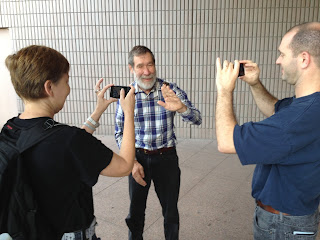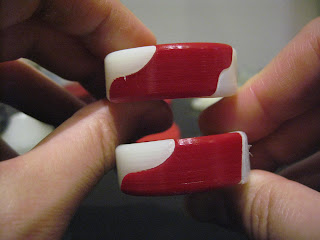When I arrived in Japan for the
International Puzzle Party many other puzzlers had already been there for quite some time, and they'd been out sightseeing and visiting. I joined a small group of friends on an unofficial trip to visit a few puzzle sights, including (pictured above) George Miller, Roxanne Wong (wearing my ivy cap) and her daughter Katherine, and Naoki Takashima.
First we visited Takafumi Haseda, who operates the
Tribox puzzle store online. The store operates in a residential apartment converted into an office, a photo studio, and a stockroom packed with puzzle merchandise. Pictured, Andreas Nortmann (too tall!), Roxanne, and Takafumi venture into the stock room search for hidden treasures.
Next we trekked to the office of
Hanayama, the maker of the world's finest mass-produced brainteaser puzzles. Above, Oskar van Deventer and his wife discovered a sign that greeted his arrival outside the Hanayama office.
A room at Hanayama displayed their huge assortment of Japanese toys and games, in addition to their world renown collections of cast puzzles.
Our next destination would have been
Puzzle Shop Torito, but the shop was scheduled to be closed for a few days. So we went sightseeing to the 2080-foot-high Tokyo SkyTree.
From the SkyTree we observed a puzzling building that exhibited an illusion like an MC Escher painting: the green roof appears to wrap around the two elevator towers in the center of the building, but the elevetor towers clearly connect to the green roof at different floors!
There's a glass floor for intrepid visitors willing to stand on thin air over 1000' above ground.
Back at the hotel, Dirk Weber successfully solved my
Twisty Trillion puzzle.
Hanayama Puzzles exhibited a fascinating display that showed how many of their most famous puzzles evolved before they went into production.
My favorite entry in the
2013 Design Competition was Bram Cohen's
Galaxy, which won a jury prize. It went on to be manufactured by Hanayama Puzzles, widely sold by puzzle stores like
Puzzle Master.
























































